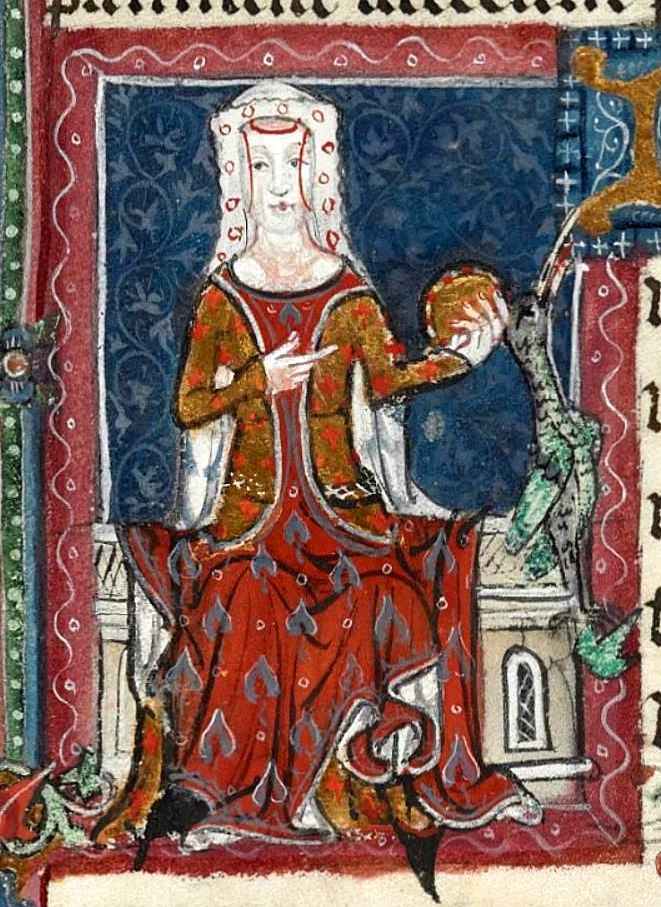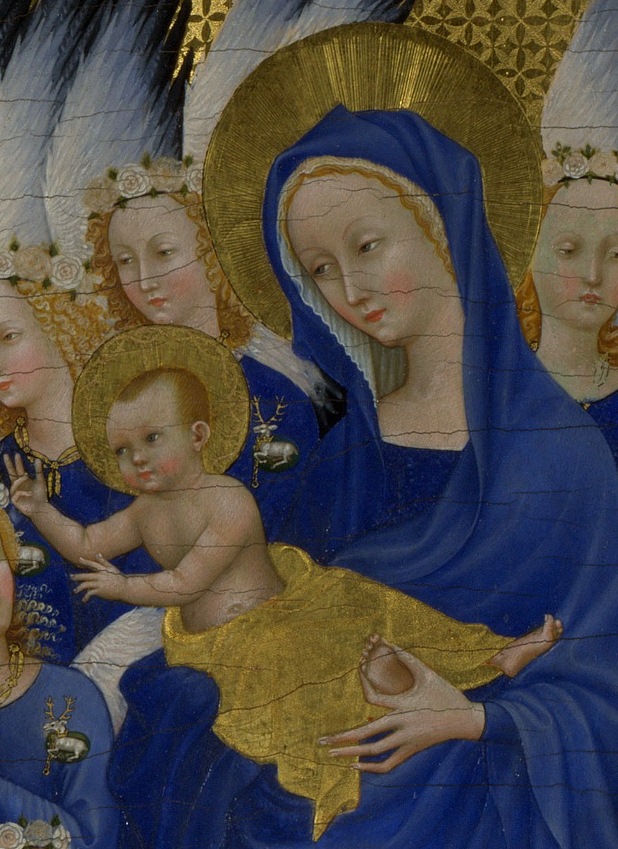by Susan Flantzer © Unofficial Royalty 2017

Joan of Kent was born September 29, 1328 at Woodstock Palace near Oxford in Oxfordshire, England. She was the third of the four children of Edmund of Woodstock, 1st Earl of Kent and Margaret Wake, 3rd Baroness Wake of Liddell. Joan’s father was the younger of the two sons of King Edward I of England and his second wife, Margaret of France, and was, therefore, a half-brother of King Edward II.
Through her second marriage to the eldest son of King Edward III, Edward, Prince of Wales (the Black Prince), Joan became the very first Princess of Wales. Besides Joan, there have been nine women who were Princess of Wales by their marriages to the Prince of Wales:
- Anne Neville, wife of Edward of Westminster, Prince of Wales (never became king, son of King Henry VI)
- Catherine of Aragon, wife of Arthur, Prince of Wales (predeceased his father King Henry VII)
- Caroline of Ansbach, wife of George, Prince of Wales (son of King George I, acceded to the throne as King George II)
- Augusta of Saxe-Gotha, wife of Frederick, Prince of Wales (predeceased his father King George II)
- Caroline of Brunswick, wife of George, Prince of Wales (son of King George III, acceded to the throne as King George IV)
- Alexandra of Denmark, wife Albert Edward, Prince of Wales (son of Queen Victoria, acceded to the throne as King Edward VII)
- Mary of Teck, wife of George, Prince of Wales (son of King Edward VII, acceded to the throne as King George V)
- Lady Diana Spencer, first wife of Charles, Prince of Wales (son of Queen Elizabeth II, divorced August 28, 1996)
- Camilla Parker Bowles, second wife of Charles, Prince of Wales (son of Queen Elizabeth II), does not use the title Princess of Wales, known instead as the Duchess of Cornwall
Joan had three siblings:
- Edmund, 2nd Earl of Kent (1326 – before October 5, 1331)
- Margaret (1327 – 1352), unmarried
- John, 3rd Earl of Kent (1330 – 1352), married Isabella of Jülich, no issue
Joan’s father Edmund, 1st Earl of Kent played an important role during the reign of his half-brother King Edward II, acting both as a diplomat and a military commander. Three years after King Edward II was deposed by his wife Isabella of France and her lover Roger Mortimer and Edward II and Isabella’s 15-year-old son succeeded as King Edward III, Edmund was accused of high treason on charges of having attempted to free the former king from imprisonment. It later emerged that Roger Mortimer himself was responsible for leading Edmund into the plot to free the former king, in a form of entrapment. Edmund, 1st Earl of Kent was executed at Winchester Castle on March 19, 1330. Joan’s mother Margaret was pregnant at the time of her husband’s execution and was confined to Arundel Castle with her young children where her last child was born.
After Edmund’s execution, the nobles begged the young King Edward III to assert his independence, which he did shortly before his 18th birthday. In October of 1330, a Parliament was summoned to Nottingham Castle, and Mortimer and Isabella were seized by Edward and the nobles. Isabella begged for mercy for Mortimer, but he was accused of assuming royal power and of various other crimes and was condemned without a trial and hanged. Isabella was held under comfortable house arrest until her death in 1358. After King Edward III regained his independence from his mother and Mortimer, he took in Margaret and her children and treated them as his own family. Joan and her siblings grew up with Edward III’s children, including Edward, Prince of Wales, Joan’s future husband.
Joan’s elder brother, five-year-old Edmund, inherited the Earldom of Kent in 1331, a year after his father had been attainted. His mother petitioned King Edward III who reversed the condemnation of Edmund, 1st Earl of Kent and recognized his heir as Earl of Kent. Little Edmund, 2nd Earl of Kent died shortly afterward and his infant brother John became the 3rd Earl of Kent. Joan’s mother Margaret briefly succeeded her brother as 3rd Baroness Wake of Liddell in 1349 but died during an outbreak of the plague that autumn. Upon his mother’s death, John, 3rd Earl of Kent succeeded his mother as 4th Baron Wake of Liddell. John, 3rd Earl of Kent and 4th Baron Wake of Liddell died in 1352 and his only surviving sibling, Joan became 4th Countess of Kent and 5th Baroness Wake of Liddell.
In 1340, 12-year-old Joan secretly married Thomas Holland without permission from King Edward III as was required. Thomas then left for overseas military duty and the Crusades. A year or two later, Joan was forced by her family to marry William de Montagu, 2nd Earl of Salisbury. Lord Salisbury entered into the marriage in good faith, without knowing that Joan had secretly married Thomas Holland. Upon returning to England in 1348, Thomas Holland declared that Joan was his wife and demanded that she be restored to him. An inquiry determined that Joan had indeed been married to Thomas Holland and that that marriage was valid, and therefore, Lord Salisbury’s marriage to Joan was invalid. In 1352, when his brother-in-law John, 3rd Earl of Kent died, Thomas Holland became Earl of Kent in right of his wife. The couple remained together for eleven years until the death of Thomas Holland on December 26, 1360.

Thomas Holland from the Bruges Garter Book, 1430/1440; Credit – Wikipedia
Joan and Thomas had five children. Through the daughters of their son Thomas Holland, 2nd Earl of Kent, they are the ancestors of many prominent figures in the Wars of the Roses, including Richard Plantagenet, 3rd Duke of York (father of King Edward IV and King Richard III), Henry Tudor (later King Henry VII) and his wife Elizabeth of York (daughter of King Edward IV), Richard Neville, 16th Earl of Warwick (the Kingmaker) and his daughter Anne Neville (wife of King Richard III). They were also ancestors of Catherine Parr, the sixth and last wife of King Henry VIII.
- Thomas Holland, 2nd Earl of Kent (1350/1354 – 1397), married Lady Alice FitzAlan, had issue
- John Holland, 1st Duke of Exeter (circa 1352 – 1400), married Elizabeth of Lancaster, a daughter of John of Gaunt, 1st Duke of Lancaster (son of King Edward III), had issue
- Edmund Holland (c. 1354), died young
- Lady Joan Holland (1356–1384), married John IV, Duke of Brittany, no issue
- Lady Maud Holland (1359–1391), married (1) Hugh Courtenay, no issue (2) Waleran III of Luxembourg, Count of Ligny, had issue
Joan was a widow for less than a year before she married Edward, Prince of Wales (the Black Prince), her first cousin once removed and the son and heir of King Edward III of England, on October 10, 1361, at Windsor Castle. In 1362, Edward was invested as Prince of Aquitaine, a region of France which belonged to the English crown since the marriage of Eleanor, Duchess of Aquitaine and King Henry II. Joan and Edward then moved to Bordeaux, the capital of Aquitaine, where they spent the next nine years. Both of their children were born in France:
- Edward of Angoulême (1365 – 1372), died of the plague at the age of five
- Richard of Bordeaux, later King Richard II of England (1367 – 1400), married (1) Anne of Bohemia, no issue (2) Isabella of Valois, no issue

Edward of Angouleme and Joan of Kent, depicted on the Wilton Diptych, 1395; Credit – Wikipedia

Richard II of England, portrait at Westminster Abbey, mid-1390s; Credit – Wikipedia
On June 7, 1376, a week before his forty-sixth birthday, Edward, Prince of Wales died at the Palace of Westminster after suffering from an illness for ten years. His father King Edward III died a year later, on June 21, 1377, and was succeeded by his ten-year-old grandson King Richard II, the surviving son of Joan and Edward.
Joan died at the age of 57 on August 7, 1385, at Wallingford Castle. She requested to be buried beside her first husband at the Church of the Greyfriars, a Franciscan friary in Stamford, Lincolnshire, England which was destroyed during King Henry VIII’s Dissolution of the Monasteries.
This article is the intellectual property of Unofficial Royalty and is NOT TO BE COPIED, EDITED, OR POSTED IN ANY FORM ON ANOTHER WEBSITE under any circumstances. It is permissible to use a link that directs to Unofficial Royalty.
Works Cited
Joan. “Jeanne de Kent.” Wikipedia. N.p.: Wikimedia Foundation, 7 Oct. 1328. Web. 3 Dec. 2016.
“Joan of Kent.” Wikipedia. N.p.: Wikimedia Foundation, 31 Oct. 2016. Web. 3 Dec. 2016.
Williamson, David. Brewer’s British Royalty. London: Cassell, 1996. Print.

